Webster Hall Through the Years
Webster Hall is a world known leading concert venue and night club in New York City today. From its beginning in 1886, it has served many purposes, held a variety of different events, and hosted many different people in its time that adds to its historical value and significance. Not only are the events held in the building part of its lasting legacy on New York, the architecture and social setting of Webster Hall play a part as well. The overall significance of the building was recognized by the New York Landmarks Preservation Committee when the building became an official landmark of New York because “Webster Hall… and has a special character and a special historical and aesthetic interest and value as part of the development, heritage, and cultural characteristics of New York City”.[1]
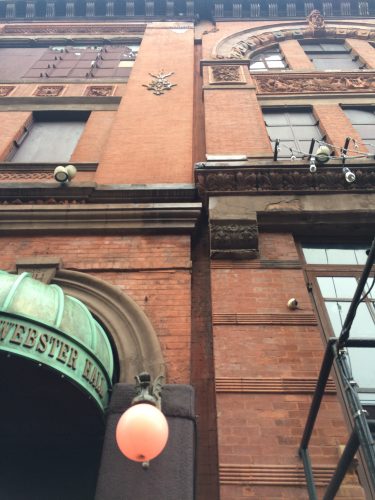
In 1886, the famous architect Charles Rentz began the building of Webster Hall for Charles Goldstein the man who was going to operate the hall and all of its functions. Charles Goldstein lived in the beautiful building with his family. Noted as one of the most beautiful buildings in the city, “The original symmetrical design of Webster Hall, in an eclectic Queen Anne style, featured three vertical sections flanked by monumental pilasters, large window groups on the third story (round arched in the center), a modillioned cornice, and a complex roofline consisting of sections of mansard roof on each end having elaborate, pedimented and scrolled dormers, and a central mansard tower rising above a large decorative plaque with a scroll bearing the name “Webster Hall” surmounted by a sunburst pediment”.[2] While living there, Goldstein began the legacy of events to take place in the
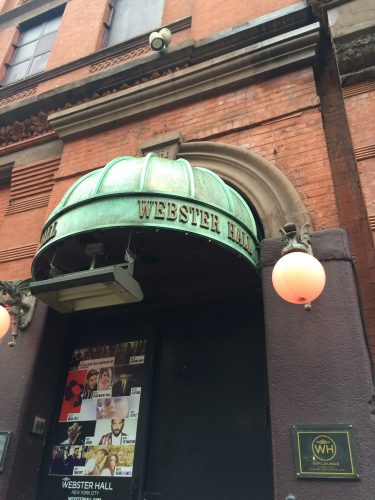
intimate East Greenwich Village building. He rented it out for performances and to blue collar immigrants of the neighborhood for private occasions. During this time, Webster Hall was used for many masquerades, sporting events, private and public meetings.
Webster Hall began to grow in its significance in the 1910s and 1920s with the growth of the Progressive reform era. The space was used as a meeting grounds for many liberal movements at the time led by immigrants and socialist reformers in the surrounding Village area. Union political organizations held many of their meetings at Webster Hall. The Clothing Workers of America, for example, an important labor reform group, held its founding convention in Wester Hall in 1914. Likewise, Margaret Sanger, an early women rights movement leader, led a strike of 119 working children on strike from the train to Webster Hall for food and care. [3]
At first, the class composition that made up Webster Hall was heavily working and lower middle class people who aimed at reforming laws in some way to better society. As time went on, Webster Hall would see many upper middle class people in the venue with the addition of live music shows. Webster Hall was not a discriminatory place in holding events at all, welcoming all types of social events, ethnicities, genders, classes, sexual orientations, and ages.

By the 1920s, Webster Hall began to take its entertainment value. Holding many masquerades and balls, it embraced the bohemian culture of the surrounding Greenwich village, openly accepting and gathering gays and lesbians dressed in drag to the flamboyant masquerades. Webster Hall was considered a safe haven for members of the LGBTQ community as many drag balls were proudly held at the space for them. In a photograph courtesy of Webster Hall History website, there is an image of a group of people at a 1920s Drag Party. Webster Hall was overall a safe haven for anyone who felt shunned from mainstream society at the time and was a place where people could openly express themselves however they pleased. With the takeover of Bohemians in the Lower East Side at this time, Webster Hall was a sacred place to them as anyone who was defying societal norms in art, music, and more could be accepted.4 Furthermore, the transformation of the venue into a speakeasy during the time of prohibition characterized the “crown Jewel of the East Village” even more.[4] It was rumored during this time, Al Capone, the famous New York City gangster was the silent owner of the hidden jewel speakeasy, Webster Hall.
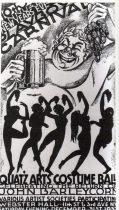
Eventually,with the end of prohibition, Webster celebrated by throwing a huge ball on New Year’s Eve called “The Return of John Barleycorn”. In a poster hung advertising the Return of the John Barleycorn, a large drawing of a fat man wearing a leaf crown is depicted holding a large mug of beer in one hand and a bundle of grapes in the other hand.[5] The presence of the man on the poster signifies the lavish and special status that legal alcohol consumption had become with the 18th amendment. Underneath the man are drawn silhouettes of women holding bundles of grapes themselves and looking as if they are going to take a bite. The presence of the women underneath the man eating the grapes signifies that now the forbidden fruit (grapes as the source of wine) could now be consumed by the general public once again.
As Webster Hall thrived in its cultural influence and popularity, it was also met with a few fires in its time-some more tragic than others. One of the more tragic fires occurred on February 22, 1938, killing 2 men- a watchmen and a porter who were on duty. The cause of this fire is believed to have been “a cigarette discarded by one of 500 guests at a dinner of an American Federation of Labor local”.[6] A lit cigarette would soon become an even greater enemy to the history of Webster Hall. On February 5, 1949, The New York Times published an article giving details about the fifth and most devastating fire to have occurred at Webster Hall due to a smoldering cigarette in the early morning hours. The fire burned for two days straight and destroyed the historically beautiful high framed mansard roof and most of the interior of the building and caused several hundred thousand dollars worth of damage, luckily no one lost their lives in this fire.[7]
After the fie of 1949, Webster Hall was resurrected into a music centered workspace in the 1950s. While still a gathering for musical performances this was not the main function at the time, rather Webster Hall became the “Webster Hall Studios”, a famous recording site. RCA records purchased the building in 1953 and revamped the building into a modern “art-deco” fashion building with a brand new ballroom that had beautiful acoustics for recording.[8] The record label then used Webster Hall as it’s east coast recording studio and drew in hundreds of world famous American artists to utilize the premises. The Grand ballroom studios became a site for music icons such as Frank Sinatra, Lois Armstrong, Tony Bennett, Perry Como, and Elvis Presley, who recorded the legendary song “Hound Dog” in 1956. According to Peter Edin, a columnist for The New York Times, “The acoustics where like that of nowhere else in the city”.[9]
Webster Hall had always been a place embracing cultural progressivism and when it came to the music it hosted, it was no less liberal. During the 1950s, it was a melting pot of different music genres and cultures including pop, rock, Latin, jazz, and more.[10] Tito Puente, for example, a legendary Latin artist was embraced among other popular “white folk” music at the time. Commenting on the diversity of Webster Hall’s setting, the New York City cultural blog explains, SOHO West explains “It exists as a unique place to experience the lively sounds from all types of cultures within the global diaspora, a fact reflective in its slogan the “Home of Universal Music”.[11] Not only was the recording space diverse in its artists culturally, but through genres as well. The Grand ballroom became a popular space to record Broadway musical sounds as well. Among the popular Broadway cast recordings are: Julie Andrews in The Boy Friend, Mary Martin in Peter Pan, Barbara Cook in Show Boat, EthelMerman in Annie Get Your Gun, Carol Channing in Hello, Dolly!, and Liza Minnelli in Flora, the Red Menace, as well as those of classical artists such as Arthur Rubinstein, Marian Anderson, and Beverly Sills in Giulio Cesare.[12]A photograph from 1961, shows the full orchestra and the vastness of the grand Ballroom as well as its beauty as it captures the recording of the soundtrack for “How to Succeed in Business Without Really Trying.[13] Another historic event of the period was on February 2, 1962 when Bob Dylan was recorded for the first time ever playing the harmonica on Belafonte’s title track “Midnight Special”. [14] RCA Victor records flaunted Webster Hall as its home during this time in competition with Columbia records.
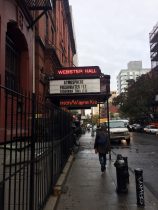
Source: personal photograph
Webster Hall began to boom into the musical entertainment center for people to come in and enjoy that it is today throughout the 1980s and into the 1990s. On May 1, 1980, Webster Hall opened its doors under the name The Ritz nightclub, a place where the walls would hear many famous musicians and become a leading rock venue in New York City. Legends like “Eric Clapton, Sting, Tina Turner, The Pretenders, Prince, Metallica, Sting, Aerosmith, Cro-Mags, KISS, BB King and Guns n Roses”.[15] A superstar performance occurred on December 6, 1980, when U2 performed their first ever US show on the stage of the Ritz.
In 1990, the Ballinger Brothers bought out the Ritz and it moved uptown. Although it is currently located still in the Lower East Side of New York, when The Ritz moved, Webster Hall reopened as New York City’s hottest nightclub and concert venue on October 2, 1992[16]. It was said to be “the first club designed with a video component, setting a style that was later borrowed by other clubs nationwide”.[17] While the venue was booming, it characterized the center of the youthful music culture at the time, drawing fans who exemplified the rebellious and outspoken generation. On August 29, 1996, The Gin Blossoms and Lush drew a massive crowd that lines up and was checked by security guards for miles. The guards had told the fans that the show had not begun, yet by the time they got in they missed one of the acts many had paid for; the guards were occupied because “almost every concertgoer was subjected to a thorough manual and electronic search by a ticket collector, followed by a meticulous inspection of key rings, key by key, and wallets, bill by bill” due to the worry of violence and drugs that the older generation associated with the new youth.[18] Even further embracing the musical and young culture of the time, Webster Hall was the location for the party release The Vibe magazine, devoted to urban music and youth culture, on August 17, 1993. The images pictured in a New York Times article about the event shows different young people of different races coming together, smiling and enjoying the night, embracing the overall welcoming aura that Webster Hall displayed for a century.[19] The 1996 New York Times article, describes the growing lines and popularity of bands playing at Webster Hall despite any social stereotypes that may be going on outside of the venue, inside everyone is one and the goal is just to enjoy music and the night, a safe haven.
At the turn of the century, Webster Hall added even more live concerts to its lineups. Superstar acts such as Paul Simon, Green Day, Michael Bublé, Jack White, Nine Inch Nails, Patti Smith, The Killers have rocked the stage.[20] In 2008, Webster Hall added an intimate 400-capactiy basement stage to its venue, the Webster Hall Studios, where emerging artists such as A Boy Named John and Modern Chemistry could perform alongside established acts looking for a tight-knit night. An additional stage was added to the venue in 2013, when the 600-caacity Marlin Room opened on the middle level. Altogether, Webster Hall can now host three concerts on three separate stages all at the same time.[21]
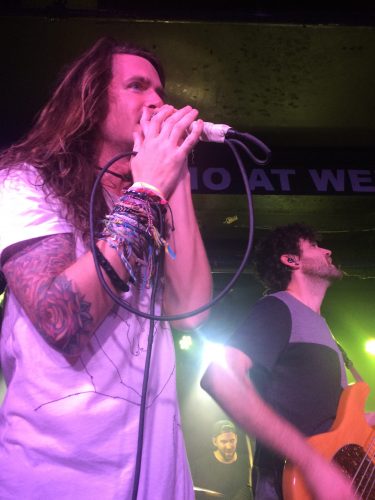

Webster Hall has been a center that has gathered New York City and American culture alike for over a century. The social reform movement for social and civil equality in the Lower East side found its home there, as Webster welcomed members of the LGBTQ community to be themselves and fight for their rights, much like it welcomed many labor unions to fight for their rights as well. In the era of prohibition, Webster Hall began to make a name for itself as the let loose free and fun center it is now. The glamorous masquerades and balls held at the hall reflected the materialistic and fast changing society that was taking place in New York and America as a whole. The many fires that broke out during the years of Webster’s standing was also reflective of the repetitive troubles (of fire) that New York was constantly facing in the development of the city. During the mid to late 1900s, Webster Hall hosted diverse musicians both in musical genres and in race. Welcoming whites, blacks, and Latinos, Webster Hall proved that it was a site that embraced the groundbreaking social changes that New York- and the nation-were trying to integrate. When America seemed to be centered around the disco clubs in the 80s and the grunge night life in the 90s, Webster became the epicenter of fans and performers alike to display the rock and roll American culture. Into the 21st century, Webster Hall officially established itself as one of New York City’s and America’s greatest performance venues for annual Halloween and New Years Parties, club nights, and rock shows. Finally, on March 18, 2008, the Landmark Preservation Committee of New York recognized Webster Hall as an official landmark. From hosting meetings and rallies for progressive reformers to offering its stages to internationally known performers, the walls of Webster hall hold so much history that reflects the culture of New York City and America.
[1] “Webster Hall.” http://www.websterhall.com/timeline/ (accessed September 28, 2016)
[2] “United States. New York City Government Office. Landmark Preservation Commission,” http://www.nyc.gov/html/lpc/downloads/pdf/reports/websterhall.pdf?epi-content=GENERIC (accessed October 2, 2016)
[3] “Webster Hall.” http://www.websterhall.com/timeline/ (accessed September 28, 2016)
[4] Neil, “As the Fans Outside Are Searched, the show Goes on,” New York Times, Aug 30 1996
[5] “Webster Hall.” http://www.websterhall.com/timeline/ (accessed September 28, 2016)
[6] “OLD WEBSTER HALL WRECKED BY BLAZE,” New York Times , February, 06 1949.
[7] “OLD WEBSTER HALL WRECKED BY BLAZE,” New York Times , February, 06 1949.
[8] “Webster Hall.” http://www.websterhall.com/timeline/ (accessed September 28, 2016)
[9] Edidin, Peter, “Arts, Briefly.” New York Times, Mar 19 2008.
[10] “United States. New York City Government Office. Landmark Preservation Commission,” http://www.nyc.gov/html/lpc/downloads/pdf/reports/websterhall.pdf (accessed October 2, 2016)
[11] “Webster Hall – Soho West,” http://sohowestnj.com/venue/webster-hall/ (accessed November 1, 2016)
[12] United States. New York City Government Office. Landmark Preservation Commission,” http://www.nyc.gov/html/lpc/downloads/pdf/reports/websterhall.pdf (accessed October 2, 2016)
[13] “Webster Hall.” http://www.websterhall.com/timeline/ (accessed September 28, 2016)
[14] “The Bowery Boys New York City History,” http://www.boweryboyshistory.com/tag/webster-hall (Accessed September 29, 2016)
[15] By, Stephen W. “WHERE ROCK LIVES the Uptown Ritz is Putting on the Glitz.” Newsday, April 5, 1989.
[16] [16] “The Bowery Boys New York City History,” http://www.boweryboyshistory.com/tag/webster-hall (Accessed September 29, 2016)
[17] Betts Mary, “United States. New York City Government Office. Landmark Preservation Commission. The New York City Landmark Preservation Committee,” August 1,2007.
[18] Neil, “As the Fans Outside Are Searched, the show Goes on,” New York Times, Aug 30 1996.
[19] “New Vibe(s).” New York Times, Aug 22 1993.
[20] “The Bowery Boys New York City History,” http://www.boweryboyshistory.com/tag/webster-hall (Accessed September 29, 2016)
[21] “Webster Hall.” http://www.websterhall.com/timeline/ (accessed September 28, 2016)
Annotated Bibliography
“Webster Hall.” New York City. N.p., n.d. Web. 28 Sept. 2016.
This link was extremely helpful because it comes directly from the venue, Webster Hall itself. This link gave an abundance of historical years, moments, pictures, and bands, all in a chronological easy to follow order, set up through an actual historical timeline. It is a great overview of specifics and interesting facts that are close to the heart of the venue itself.
“OLD WEBSTER HALL WRECKED BY BLAZE.” New York Times (1923-Current file): 1.Feb 06 1949. ProQuest. Web. 29 Sep. 2016.
This primary source from the New York Times was extremely helpful in demonstrating one of the big changes that Webster Hall would go through in its time due to a physical disaster. It also provided a primary source of an image of the fire from the time. Lastly, this article also delved into some historical background of Wester Hall in its organs of the early twentieth and late eighteenth century.
Edidin, Peter. “Arts, Briefly.” New York Times (1923-Current file): 1. Mar 19 2008. ProQuest.Web. 1 Oct. 2016.
Importance of Webster hall in becoming a landmark as well as the cool history it has
“New Vibe(s).” New York Times (1923-Current file): 390. Aug 22 1993. ProQuest. Web. 1 Oct. 2016.
Primary source short article clipping explaining the magazine introduced at Webster Hall surrounding the music scene and youth culture, further emphasizing the growing social drawing and impact that the venue has.
NEIL S. “As the Fans Outside Are Searched, the show Goes on.” New York Times (1923-Current file): 1. Aug 30 1996. ProQuest. Web. 5 Oct. 2016.
This primary source from an article in the NY Times 1996, describes the growing lines and popularity of bands playing at Webster Hall despite any social unrests that may be going on outside of the venue-inside, everyone is one and the goal is just to enjoy music and the night, a safe haven.
“Webster Hall.” Audio blog post. Bowery Boys History. Word Press, 10 Aug. 2009. Web. 29 Sept. 2016.
I decided to use this resource as a possible audio component of my guidebook, it is interesting to hear the history of Webster Hall and some it’s origins through a podcast, rather than read it in a summary format. I want to especially focus on the huge social change the venue brought through its music in my guide book, so to be able to hear more details about the early history of Webster if more information is wanted, it becomes more convenient and a different approach than the typical reading of an article.
“Out Among the Builders,” Real Estate Record & Builders Guide, June 19, 1886. 29 September 2016.PDF.
This is a primary source that is a documentation of all of the building that occurred in NYC. In this, Rentz, the architect, of Webster Hall, describes his layout plan for the structure and style of the annex to be built.
United States. New York City Government Office. Landmark Preservation Commission. N.p., 30Oct. 2007. Web. 2 Oct. 2016.
This is a PDF version document of the NYC Landmarks Preservation Commission public hearing notes on the proposal to make Webster Hall a Landmark., It has an abundant amount of information on the history of Webster, especially the significant events that make the venue such an important part of NYC history.
United States. New York City Government Office. Landmark Preservation Commission. The New York City Landmark Preservation Committee. By Mary Betts. N.p., 7 Aug. 2007.Web. 2 Oct. 2016.
This is a primary resource release statement on the announcement that Webster Hall will be officially recognized as an NYC Landmark. This approval in this letter highlights the acknowledgement of significant event sin the history of Webster Hall on the impact it has made in NYC.
“Webster Hall – Soho West.” Soho West. 12 June 2015. Web. 1 Nov. 2016.
Insights to Tito Puente and other Latin musicians populating Webster Hall at the time.
By, Stephen W. “WHERE ROCK LIVES the Uptown Ritz is Putting on the Glitz.” Newsday, Combined editions ed.: 03. Apr 05 1989. ProQuest. Web. 1 Nov. 2016 .
This website offers insight on The Ritz 19902
My first “Webster Hall” experience concert was in 1987 to see Nina Hagen when it was still called The Ritz. I was at the 1996 Lush/Gin Blossoms show. Lush’s Miki Berenyi was not happy they were the opening act after they’d [rightly] assumed they were headlining. And she let everyone know such. It would be that version of Lush’s last NYC performance, as drummer Chris Acland tragically passed away just over two months later.